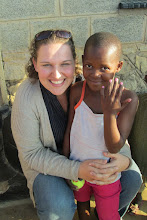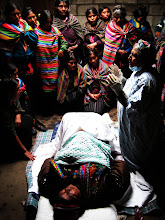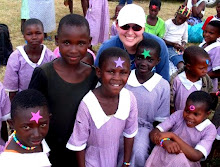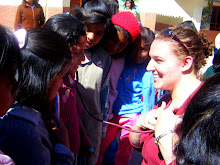
The highlight of Amanda and my trip to northwestern Botswana was, without a doubt, our time with a group of Naro San bushmen at the D’Qae Qare Game Reserve. Early on our first day at the reserve, we were driven out to a little bushmen village on the reserve. The Naro no longer live in traditional villages, like the one where we spent our day… Since their removal from their ancestral lands in the central Kalahari Desert, most Naro San live in poverty in government designated settlements (such as the village of D’Kar, where Amanda and I later spent a day during our trip). But for our visit, a group of Naro San came out to join us in the village…

True to our Peace Corps roots, it didn’t take long for Amanda and I to feel right at home relaxing on burlap sacks around the ground.
 The San women immediately put us to work, learning how to make traditional beaded necklaces out of ostrich eggs…. And boy is it a labor intensive process! To start, the women break the ostrich eggshells into pieces. Each piece then has a tiny hole drilled into it using a handmade drill (a nail in a wood stick). Afterwards, the
The San women immediately put us to work, learning how to make traditional beaded necklaces out of ostrich eggs…. And boy is it a labor intensive process! To start, the women break the ostrich eggshells into pieces. Each piece then has a tiny hole drilled into it using a handmade drill (a nail in a wood stick). Afterwards, the  pieces can be boiled/fried to give the eggshells darker colors of brown. The eggshell pieces with hand-drilled holes are then strung onto a piece of string and painstakingly shaved down against stones until all the pieces have the same round geometry and size. Afterwards, the San women demonstrate their true artistry by weaving these ostrich shell beads into elaborate designs, in the forms of beautiful necklaces, earrings, bracelets, and classic headbands.
pieces can be boiled/fried to give the eggshells darker colors of brown. The eggshell pieces with hand-drilled holes are then strung onto a piece of string and painstakingly shaved down against stones until all the pieces have the same round geometry and size. Afterwards, the San women demonstrate their true artistry by weaving these ostrich shell beads into elaborate designs, in the forms of beautiful necklaces, earrings, bracelets, and classic headbands. 

As we sat around making necklaces, the women shared stories and bits of their cultural history- an incredible legacy that boasts being one of the most ancient cultures still surviving in the 21st century.
 The Naro San, who are one of only many distinct tribal peoples that make up the “San” or “bushmen” of southern Africa, have their own distinct language, Naro. Despite my attempts at trying to learn even one or two of our companions’ names in Naro, I walked away utterly defeated. With more than 30 distinct click sounds, the language is absolutely baffling in it’s complexity and I spent much of my trip awestruck by it’s sounds. The San people put incredible emphasis on music and dance, and we were graced with much of it during our time there. The women especially LOVE to sing and do so during much of thei
The Naro San, who are one of only many distinct tribal peoples that make up the “San” or “bushmen” of southern Africa, have their own distinct language, Naro. Despite my attempts at trying to learn even one or two of our companions’ names in Naro, I walked away utterly defeated. With more than 30 distinct click sounds, the language is absolutely baffling in it’s complexity and I spent much of my trip awestruck by it’s sounds. The San people put incredible emphasis on music and dance, and we were graced with much of it during our time there. The women especially LOVE to sing and do so during much of thei r work, or as an expression of thanks, joy, or other emotions. Their music has an almost hauntingly eerie, yet strong resilient quality to it… Throughout the night, from our bushmen hut on the other side of the reserve, we could hear the women continuing to call out to each other. It was a lovely form of music that I could never even begin to recreate or participate in myself. Most songs, and by association many dances, are associated with animals or pieces of nature. The San seem incredibly worshipful for everything that surrounds them- the sky, water, a tuber found beneath a bush, a leaf whose tea heals, an eland’s grace and beauty. Throughout the day, we would be out in the bush walking or sitting somewhere and the women would break into a complex harmony of calls and
r work, or as an expression of thanks, joy, or other emotions. Their music has an almost hauntingly eerie, yet strong resilient quality to it… Throughout the night, from our bushmen hut on the other side of the reserve, we could hear the women continuing to call out to each other. It was a lovely form of music that I could never even begin to recreate or participate in myself. Most songs, and by association many dances, are associated with animals or pieces of nature. The San seem incredibly worshipful for everything that surrounds them- the sky, water, a tuber found beneath a bush, a leaf whose tea heals, an eland’s grace and beauty. Throughout the day, we would be out in the bush walking or sitting somewhere and the women would break into a complex harmony of calls and  responses- When we asked our guide, Tomku what they were doing she would just laugh, “They’re happy!” she’d reply. “They’re giving thanks for the water in that pond!” It was an incredible gift to have the opportunity to witness a wholly different, and yet utterly joy-filled, form of worship in the form of dance and music.
responses- When we asked our guide, Tomku what they were doing she would just laugh, “They’re happy!” she’d reply. “They’re giving thanks for the water in that pond!” It was an incredible gift to have the opportunity to witness a wholly different, and yet utterly joy-filled, form of worship in the form of dance and music. 
If nothing else can be said about San culture, it’s that it’s people are story-tellers. Their stories are beautiful, creative, and have endured through millennia. In another testament to their utter devotion to nature and all it’s creatures, San stories are filled with narratives of humans becoming animal and animals becoming human. These trends seemed to permeate their story telling, both orally and through dance, where dancers often imitated animals stalking one another or a bird flying. In this way, San teach their children to deeply respect the spirit, essence, and rights of EVERY living thing. As hunters and gatherers, the San people traditionally relied heavily on the land and it’s animals, yet they never abused or took for granted this privilege. They viewed humans as animals, and animals as equal spirits to humans.

Traditionally, San lived as hunter gatherers (although this way of life has quickly disappeared due to seizure of San lands by governments and agriculturalists.) Thus, the highlight of our day was going on a bushwalk. During the several hours we spent in the bush with the women and men, Amanda and I were overwhelmed by the incredible wealth of knowledge held by these peoples.


Their intimate relationship with the land could not possibly be overstated. During the walk, our two male guides pointed out tracks from various animals- reading their prints like I might read a book, and easily translating the events of what
 had happened to
had happened to

 which animals when. They could distinguish between clusters of animal prints and droppings, without the slightest hesitancy. It quickly became clear to us that EVERY plant and tree in the Kalahari Desert has a unique purpose for the San. With each step, the women would rapidly point out a plant that could poison a grown antelope with a single scratch of an arrow, a root that can be chewed to clean your teeth, a seed that when brewed relieves pain, a bug that is delicious when fried and ground into a paste, or a piece of bark that can be used as a knife to sever the umbilical cord after a woman has given birth. Their knowledge was absolutely overwhelming, and left me utterly in awe.
which animals when. They could distinguish between clusters of animal prints and droppings, without the slightest hesitancy. It quickly became clear to us that EVERY plant and tree in the Kalahari Desert has a unique purpose for the San. With each step, the women would rapidly point out a plant that could poison a grown antelope with a single scratch of an arrow, a root that can be chewed to clean your teeth, a seed that when brewed relieves pain, a bug that is delicious when fried and ground into a paste, or a piece of bark that can be used as a knife to sever the umbilical cord after a woman has given birth. Their knowledge was absolutely overwhelming, and left me utterly in awe. Midway through our walk, the men found two specific trees they’d been watching for… They swiftly broke off a large piece of a soft wood, and used a fading knife to cut a thin notch in it. They then took a thin rod of hard wood from another tree and shaved it down to a smooth surface. They proceeded to gather three distinct types of grasses, and layer them carefully in a pile. On the pile of dried grasses, they placed the softer wood with the notch, and into the notch they placed the hard
 wood rod. With a fast rubbing motion they spun the hard wood against the soft. In less than 3 minutes, smoke began to unfurl from the lower soft wood, and it wasn’t long before they were blowing embers to life in a small fire. Amanda and I looked on in disbelief at the ultimate survival skill- making fire from rubbing two sticks together. As if we needed one more reason to feel utterly inferior to the San’s knowledge and prowess in the Kalahari Desert. Where we saw nothing but inhospitable desert that would likely kill us in less than 24 hours, the San saw a lush wonderland of resources and food. It was incredible to witness!
wood rod. With a fast rubbing motion they spun the hard wood against the soft. In less than 3 minutes, smoke began to unfurl from the lower soft wood, and it wasn’t long before they were blowing embers to life in a small fire. Amanda and I looked on in disbelief at the ultimate survival skill- making fire from rubbing two sticks together. As if we needed one more reason to feel utterly inferior to the San’s knowledge and prowess in the Kalahari Desert. Where we saw nothing but inhospitable desert that would likely kill us in less than 24 hours, the San saw a lush wonderland of resources and food. It was incredible to witness! 
That evening, after the bush walk and a quiet dinner, we gathered around the fire. We women sat around the fire in the sand, or on burlap sacks, as the men prepared to perform a traditional San healing ritual… The ritual, commonly called a “trance dance” for the trance-like state the dancers assume, is traditionally performed by men… But as we saw that night, can also sometimes be performed by older female healers.

As the older women piled on logs to build the fire, one of the women started singing. She was quickly joined by all the women seated around the fire in a wide circle. The air filled with an almost discordant harmony, and their gentle clapping- a rhythm which I, at times, could hardly follow, yet everyone else present seemed to know by heart. The men approached the fire, dressed in traditional skins around their waists, brightly beaded headbands, and ropes of shell-shakers wrapped around their legs, such that each step added
 to the rhythmic music. They settled into a rhythm… Around and around the fire they circled, in a steady shuffling rhythm that drove deep divots into the sand where they danced. Their motions were hypnotic in their repetition, and I could see them and the circle of women around relax into the music.
to the rhythmic music. They settled into a rhythm… Around and around the fire they circled, in a steady shuffling rhythm that drove deep divots into the sand where they danced. Their motions were hypnotic in their repetition, and I could see them and the circle of women around relax into the music. With each new song, Tomku would lean over and explain, “This one is for the Eland.” Or “this is like the flight of a bird.” I can’t say how many songs passed before I noticed a change… It was subtle,
 but eventually it was there. The elder of the two men shuffled now without looking- eyes closed. His motions became more erratic, less controlled, more drunken almost. His movements seemed to become more animal and less human, as he stumbled around the fire as if searching for something only he could sense. Finally, he would land on a person in the circle- one who required healing. In his trance state, he laid hands on the ailing person- seeking for the source of the unseen illness or pain. He might stand for several minutes there, manipulating the body with pushes and pulls- as if trying to align the body back into health. Or on occasion, he would reach right into the roaring fire behind him to fish out a red hot ember. He would then drop the ember into a tortoise shell that hung around his neck with thread, and wave the now smoking tortoise shell, and herbs within beneath the nose of the person being healed.
but eventually it was there. The elder of the two men shuffled now without looking- eyes closed. His motions became more erratic, less controlled, more drunken almost. His movements seemed to become more animal and less human, as he stumbled around the fire as if searching for something only he could sense. Finally, he would land on a person in the circle- one who required healing. In his trance state, he laid hands on the ailing person- seeking for the source of the unseen illness or pain. He might stand for several minutes there, manipulating the body with pushes and pulls- as if trying to align the body back into health. Or on occasion, he would reach right into the roaring fire behind him to fish out a red hot ember. He would then drop the ember into a tortoise shell that hung around his neck with thread, and wave the now smoking tortoise shell, and herbs within beneath the nose of the person being healed. 
This went on for hours… Song after song. Person after person. The trance seemed to take a toll on the healers, for eventually they dripped with perspiration from the strain of their never-ending dancing. Again and again, the would return to the rhythm, as if to dance themselves back into a trance. At one point, an elderly woman who we’d been told was a healer, stood up and joined the dance. She also entered a trance state, that was so powerful we were told she had to be helped down from it when the night ended.
Long after Amanda and I headed back to our bushmen huts, I could hear the Naro women in different villages calling to each other through the night… Coming down from the high of the trance, or potentially sending messages of thanks out into the dark. I fell asleep to the lonely, beautiful sound… A peaceful end to a truly magnificent day of cultural immersion.
With Love from Botswana… Mary E.





